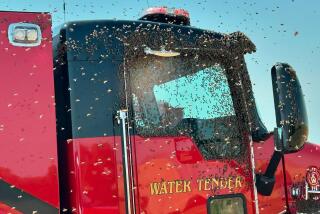Wild Bee Destruction Urged in 8,000-Square-Mile Area : Panel Seeks State War on ‘Killers’
BAKERSFIELD — A panel of experts today urged destroying all colonies of wild bees in a nearly 8,000-square-mile area surrounding the Kern County site where the first U.S. intrusion of fierce Africanized honeybees was discovered.
The action, along with a controlled sampling of commercial hives in a 400-square-mile quarantine zone around Lost Hills, would be aimed at containing the infestation of the so-called killer bees.
The group’s proposals are advisory only, and must be approved by state Agriculture Director Clare Berryhill, who is attending the Bakersfield meeting.
George Loughner, executive secretary of the state Agriculture Department, announced the proposals after a 45-minute meeting of the five-member panel in Bakersfield, about 45 miles southeast of the tiny community of Lost Hills, where an underground nest of the aggressive African bees was found last month.
Long-Term Effect ‘Improbable’
Loughner said it was “highly improbable there will be any long-term effect” of the Africanized bees upon the area because of “genetic dilution” that occurs when the fierce African-strain bees mate with the more docile domestic honeybees.
The panel called for the destruction of all feral, or wild, bee colonies in a 50-mile radius around Lost Hills, about 7,850 square miles. The experts, who said the destruction could be accomplished with pesticides or cyanide, also urged sample testing the commercial, domestic hives in the 400-square-mile restricted zone prior to lifting the quarantine.
Berryhill has said there was “a remote possibility” that the quarantine area would be sprayed with pesticides from aircraft. But aerial spraying “doesn’t seem to be a very good option, because the bees live underground anyway. I don’t know how effective it would be, if at all.”
Loughner said a suspicious nest discovered Monday from which a swarm of angry bees chased a scientist for 200 yards contained domestic bees, not African. The expert was wearing protective clothing and was not hurt.
The scientist who was chased is entomologist Norman Gary of UC Davis, head of the advisory panel.
4 Days to Identify
It takes scientists up to 30 hours over four working days to tell the difference between an African honeybee and a domestic bee.
Officials hope to set up a mobile laboratory in the quarantined area.
Searchers were using boxes previously occupied by domestic bees as lures for African bees. If any killer bees are trapped, searchers plan to track their flight paths back to their colonies.
Department spokesmen said that over the weekend, workers discovered 12 swarms of wild bees above ground, but when stirred up they quieted within a few minutes like domestic bees.
Authorities destroyed the swarms with aerosol pesticides anyway, sending a few bees from each colony to laboratories.
Searchers, who have mapped the commercial and hobbyists’ hives in the area, are making a property-by-property check for wild bees situated, for example, under house eaves or in open pipes.
More to Read
Sign up for Essential California
The most important California stories and recommendations in your inbox every morning.
You may occasionally receive promotional content from the Los Angeles Times.









